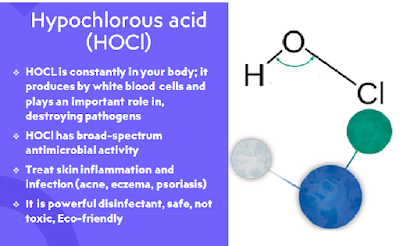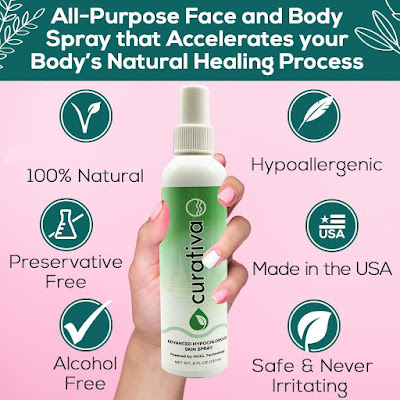 Ever heard of hypochlorous acid? New to me. Also for my computer, as it says I'm spelling this wrong. But more and more I'm reading that a bottle of hypochlorous acid spray is becoming a must have at home item. An introduction.
Ever heard of hypochlorous acid? New to me. Also for my computer, as it says I'm spelling this wrong. But more and more I'm reading that a bottle of hypochlorous acid spray is becoming a must have at home item. An introduction.
- Chemical formula of ClOH, or just chlorine, oxygen and hydrogen. Sometimes called HOCl.
- Discovered in 1834 by French chemist Antoine Jerome Balard.
- Before antibiotics, hypochlorous acid was a go-to disinfectant.
- Widely used in World War I.
- However, the lack of shelf stability prevented it from becoming a household staple.
- All mammals naturally make hypochlorous acid to fight infection.
- It is an acid that forms chlorine when dissolved in water.
- Your white blood cells make hypochlorous acid as a tool against foreign bodies.
- Will destroy pathogens in low concentrations.
- Good spray for open wounds.
- E. coli exposed to hypochlorous acid loses viability in less than 0.1 seconds. 100% growth inhibition in 5 minutes.
- Is listed as one of the World Health Organization's essential medicines.
- Approved by the U.S. Food and Drug Administration for use of food products and in certain clinical applications.
- Classified as non-hazardous by the Environmental Protection Agency.
- Doesn't irritate the skin, eyes or lungs.
- In addition to treatment of surface wounds, can be used for household cleaning, including for pet areas and baby products. Can also treat acne and eczema.
- Don't confuse hypochlorous acid (ClOH or HOCl) with sodium hypochlorite (NaClO), which is the main ingredient in household bleach products.
- Why have I not heard of hypochlorous acid?
- It is chemically unstable in water, turning just into salt-water.
- However, more recently, a way was found to keep it in solution.
- The further development of continuous flow electrochemical cells has been implemented in new products, allowing for in-situ generation of hypochlorous acid.
- The recent pandemic brought this option to the attention of the public.
- Hand sanitizers made with alcohol are useless against COVID-19.
- Water needs to be above 10 F to kill this virus, which is too hot for handwashing.
- Hypochlorous aid disinfects COVID-19 and other viruses.
- During the pandemic, began to be used for misting tunnel entries and corridors at mass transit facilities.
- After the pandemic, new manufacturing processes now make hypochlorous acid products with a shelf life of up to two years if kept at room temperature and away from sunlight. A manufacturing date is stamped on the bottle
- I just happened to read about it in the May issue of Scientific American: The Nontoxic Cleaner That Kills Germs Better Than Bleach--And You Can Use It On Your Skin.
- Curativa Bay was probably the first to introduce hypochlorous acid in 2016.
- Magic Molecule was an early seller.
- Force of Nature, sells countertop electrolysis machines for home use. But this takes time and effort.
- Briotech sells pure hypochlorous acid good for two years, but recommends using within six months after opening the bottle.
- InEurope, Sentinox sells a nasal spray (only 0.0005% ClOH (also called HOCl), and is recommended for COVID-19, RSV (respiratory synctial virus) and other acute respiratory infections.
- Harper's Bazaar has a top ten list for facial care. None of the above companies is here because they are for antiseptic use.
O
When my seatmate on a crowded train coughed the entire ride, I lifted my mask and sprayed HOCl directly up my nose; for good measure, I also soaked my eyes.
Here’s what happened: I got sick with type A influenza. My husband got it first, and I didn’t try to avoid the inevitable. Just after recovering from the flu, I picked up COVID at a large family gathering. Given the nature of airborne respiratory viruses, these events didn’t sour me on HOCl. I was diligent about spritzing myself and objects of potential exposure during travel, but it’s not like I was excusing myself from dinner conversations to take a huff of the stuff. Without constant hypervigilance and social isolation, your time comes when your times comes. I can’t live in a fog of aerosolized HOCl even if part of me wants to.














Comments
Post a Comment